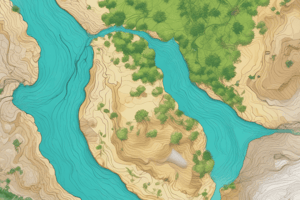Podcast
Questions and Answers
How is discharge calculated?
How is discharge calculated?
- By dividing the width of the stream by its depth
- By adding the width of the stream to its depth
- By multiplying the width of the stream by its depth
- By multiplying the cross-sectional area of the stream by its average velocity (correct)
What happens to the velocity if the cross-sectional area of a stream increases?
What happens to the velocity if the cross-sectional area of a stream increases?
- Velocity decreases (correct)
- Velocity increases
- The relationship between velocity and area is unpredictable
- Velocity remains the same
What are floodplains?
What are floodplains?
- Flat areas adjacent to river channels that are occasionally flooded (correct)
- Regions with excess water drainage
- Areas that are never flooded
- Mountainous regions prone to landslides
How are oxbow lakes formed?
How are oxbow lakes formed?
What is a drainage basin?
What is a drainage basin?
What does recurrence interval refer to in relation to floods?
What does recurrence interval refer to in relation to floods?
What is one factor contributing to the formation of deep, V-shaped valleys in mountain streams?
What is one factor contributing to the formation of deep, V-shaped valleys in mountain streams?
What does the angle of repose refer to in relation to loose material on a slope?
What does the angle of repose refer to in relation to loose material on a slope?
What happens to the gradient (slope) of a stream as it flows downstream?
What happens to the gradient (slope) of a stream as it flows downstream?
How does the channel width change as a stream flows downstream?
How does the channel width change as a stream flows downstream?
What is lateral erosion in the context of stream dynamics?
What is lateral erosion in the context of stream dynamics?
How does limited vegetation at high altitudes impact stream dynamics?
How does limited vegetation at high altitudes impact stream dynamics?
Flashcards are hidden until you start studying




